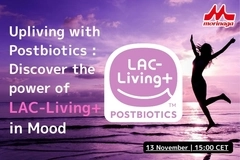Product and format innovations spotlighted in dynamic vitamins market
18 May 2023 --- Demand for vitamins soars as consumers are increasingly conscious about their health and well-being, looking for products in health areas such as cognition, mood, immunity and beauty from within. As vitamin deficiencies remain prevalent, new product formats and improved delivery systems are set to shake up the market.
Innova Market Insights reported that vitamin and mineral launches grew by 20% annually from 2018 to 2022. Although immune health remained the leading claim, the market researcher highlights a potential to innovate in mental acuity products, as these showed the fastest annual growth at 99% (2018-2022).
NutritionInsight speaks with professionals from Lycored, Bart, DSM-Firmenich, Gnosis by Lesaffre and PharmaLinea about the latest developments in the high-demand industry.
“Due to the wide range of benefits vitamins can provide and their familiarity with consumers, the opportunity for vitamins to play a role in bumping up the wellness factor in end applications is significant,” says Christiane Lippert, global product manager Vitamins & Delivery Systems at Lycored.
“We see the B vitamin group, C, D and K leading the way in cognitive and mood and C, D, E in the immunity space. Popular vitamins in the beauty-from-within area for skin and hair applications continue to be B group vitamins – B7 Biotin, B3 Niacin, B9 Folic acid and B12 Cobalamin) – alongside vitamins C and D.”

 More and more people will be willing to use technological solutions to get personalized dietary solutions, predicts Adamczyk.“More and more people will be willing to use technological solutions to get personalized dietary solutions. This also applies to supplementation and obtaining accurate health solutions tailored to a person’s health needs,” adds Żaneta Adamczyk, head of the export department at Bart.
More and more people will be willing to use technological solutions to get personalized dietary solutions, predicts Adamczyk.“More and more people will be willing to use technological solutions to get personalized dietary solutions. This also applies to supplementation and obtaining accurate health solutions tailored to a person’s health needs,” adds Żaneta Adamczyk, head of the export department at Bart.
New product formats
In new product launches, vitamin products are increasing their efforts to stand out, explains Matevž Ambrožič, marketing and PR director at PharmaLinea. Added-value sources are becoming increasingly popular while companies use innovative delivery formats.
“As consumers experience pill fatigue and search for more enjoyable forms, we have seen a rise in more fun formats like gummies,” agrees Lippert.
“Additionally, the desire for functional foods and beverages only continues to increase, creating new opportunities within the health and wellness market to cross over into the beverage category we see gaining traction.”
Philippe Caillat, global market manager at Gnosis by Lesaffre, recognizes that brand owners formulate beverages and confectionery with the company’s vitamin K2.
“This brings certain challenges that technology can answer. Ensuring the stability of menaquinone ingredients such as vitamin K2 menaquinone-7 (MK-7) can be a complicated task – research shows that moisture and mineral salts are critical variables for degradation, driving the need for a protective technology to shelter the menaquinone molecules during shelf life.”
Gnosis by Lesaffre has developed a proprietary technology – vitamin K2 Matrix – to protect the MK-7 particles without coating, additives or additional ingredients. This technology simplifies the formulation process for complex K2 products. It is also applied to the company’s MenaQ7 ingredient to offer formulators a clean-label ingredient.
Adding value to commodities
While the vitamin category has been widely commoditized and driven by low prices, recent trends show the rise of ingredients with added value, foresees Maja Orešnik, science & research director at PharmaLinea.
Added value options typically include “improved characteristics of vitamins, especially seen as improved absorption and retention in the blood, better solubility and bioavailability.”
 Lippert notes there is a rise in formats such as gummies as consumers experience pill fatigue. “People expect noticeable effects from supplementation. They do not want to waste either time or money on unproven forms of vitamins,” adds Adamczyk from Bart. “More and more often, they choose advanced solutions to improve the quality of life. Very often, these are vitamins and minerals with clinically proven effectiveness.”
Lippert notes there is a rise in formats such as gummies as consumers experience pill fatigue. “People expect noticeable effects from supplementation. They do not want to waste either time or money on unproven forms of vitamins,” adds Adamczyk from Bart. “More and more often, they choose advanced solutions to improve the quality of life. Very often, these are vitamins and minerals with clinically proven effectiveness.”
Lycored’s Lippert adds that consumers are looking for opportunities to meet their multiple supplementation needs at the same time. “Because of the very different natures of this broad spectrum of end applications, a single vitamin delivery format isn’t a one size fits all option.”
Improved stability
Adamczyk sees liposomal products as a critical driver for the dynamic vitamin market, where active ingredients are enclosed in nano lipid particles. She expects these will evolve as supplements with health functions like improved mental well-being.
She highlights that Bart has created a granular form of liposomal vitamin C under the Liposovit-C DIRECT brand, which is used in quickly dissolving products or for direct consumption.
“The unique liposomal form of vitamin C helps to bypass digestive barriers and goes directly to the body’s cells without irritating the digestive tract. In addition, Liposovit-C DIRECT is characterized by increased bioavailability compared to standard vitamin C, which effectively supports our immune system.”
Lippert adds that a Lycored case study found the company’s Capsudar D2 encapsulated vitamin provided the opportunity to add more actives in a formulation, offering brands the potential for more ingredients and associated claims that helps them to differentiate their product.
“Microencapsulation also protects against cross interaction with other ingredients, improves stability and allows for cost savings through lower content required, smaller pack sizes, fewer throw-aways, reduced shipping and warehousing costs.”
Optimizing delivery formats
Technology is an essential part of the vitamin business, as it enables companies to optimize the active ingredients for various nutritional applications, explains Ozren Zimonja, global product marketing manager of Vitamins, Health Nutrition & Care at DSM-Firmenich.
 Zimonja lists energy, brain, heart and bone health among the most popular vitamin trends.“We utilize a range of cutting-edge technologies (such as spray-drying, granulation and beadlet technology), which play a critical role in ensuring that our active ingredients are precisely formulated and ready to suit a wide range of applications.”
Zimonja lists energy, brain, heart and bone health among the most popular vitamin trends.“We utilize a range of cutting-edge technologies (such as spray-drying, granulation and beadlet technology), which play a critical role in ensuring that our active ingredients are precisely formulated and ready to suit a wide range of applications.”
He sees a growing need to leverage customized blending technologies in the dynamic vitamin market. As such, DSM offers customized premix solutions. “Customers are looking to get new products to market quickly while ensuring compliance with the ever-changing local regulatory environments.”
Growing consumer awareness
Zimonja lists energy, brain, heart and bone health among the most popular vitamin trends, while eye health concerns are rising.
“When it comes to nutrition, according to our DSM Global Health Concerns 2023 Study – around 20.000 participants – 41% of consumers believe that the number of vitamins consumed matters and 58% actively include vitamin-rich foods in their diet.”
“Consumers’ awareness of different vitamins varies. Vitamin C is the most well-known, with 78% of consumers being familiar with it, followed by vitamin D, A and E, with 72%, 65% and 63%, respectively.”
The opportunities are also the challenges, warns Caillat from Gnosis by Lesaffre. “More consumers understand the importance of vitamins as an approach to preserving health and wellness, but this also brings challenges of confusion and misinformation stemming from suppliers that piggyback on others’ research and cut corners on quality.”
Vitamin deficiencies
Though consumer awareness of vitamins is growing, Lippert highlights that vitamin deficiencies place a particular burden on health institutions in many countries.
“This issue is quite under-stated, as consumer diets rarely contribute to optimal nutrient levels.”
For example, “last year a new study carried out in the UK highlighted that high dose vitamin B6 tablets had been shown to reduce feelings of anxiety and depression amongst young adults after one month of supplementation,” Lippert underscores.
Zimonja adds that vitamin D has significantly contributed to fighting COVID-19 as it reduces the risk of acute respiratory tract infections and plays a role in the innate and adaptive immune response.
“It is estimated that 88% of the world’s population has sub-optimal vitamin D levels (<75 nmol/L). Deficiency levels are higher in certain regions, such as Europe and the Middle East. Depending on age, the specific region of residence and deficiency status, building up vitamin D levels can take a long time (up to three months or more).”
By Jolanda van Hal
















